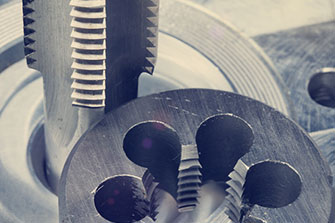
Benefits of TiN (Titanium Nitride) Coating for Machining Tools
Decades ago, tool manufacturers discovered that coating machining tools with Titanium Nitride (TiN) would provide for longer lasting devices. It was found then that TiN coating is inert and will reduce friction as well as adding resistance to wear.
Some of the most significant benefits of TiN coating on cutting tools for production machining include:
- Increasing tool life
- Improving the quality of the product’s surface
- Increasing the rate of production
The TiN Coating Process
The application of TiN coated tools is made with one of two processes; chemical vapor deposition (CVD) and physical vapor deposition (PVD).
In the CVD process, the materials are placed into a chamber where gas is pumped in at 950 to 1,100 degrees Celsius, allowing a thin layer of TiN to be deposited onto the tools.
The PVD process is a bit more complex. In this case, the tools are placed on a carousel inside a chamber. As the carousel rotates, a strong negative electric charge is applied to the tools. Meanwhile, a chunk of titanium (or titanium aluminum) is hit with an electron beam vaporizing the metal. With their immense positive charge, the titanium and aluminum ions are drawn to the negative-charged tools and nitrogen is then pumped into the chamber. When this process is completed correctly, it will form the TiN on the surface of each component.
The thickness of the coating material makes a significant difference in the life of your tools, as well as their performance. Generally, the CVD coatings are noticeably thicker than PVD coatings, thus allowing a quality surface on steel alloy as well as cast iron applications. Also, low carbon and stainless steel materials bode well with thinner layers.
Properties of TiN
Hardness (Vickers): 2,300 (81 Rc)
Oxidation Temperature: 550°C (1050°F)
Friction Coefficient: .65
Thickness: 2-4 microns
Surface Roughness (Ramm): .20
Advantages of TiN Coating Tools
The difference in the two coatings is more than just the thickness of the surface though, and just understanding the process can help one see the distinct advantage of coating tools with titanium nitride. But we’re going to elaborate a bit more on the benefits you will gain from applying a TiN coating to your devices. These advantages include:
- Appearance
- Superior adhesion to the natural surface
- High chemical inertness
- Resistance to high temperatures
- Reduced wear due to abrasion
- Improved tool life of at least twice as long and as much as 10 times longer than tools that are not coated
Other advantages you will gain by utilizing TiN coating is a low coefficient of friction with many materials, thus increasing lubricity which will result in superior surface finishes. Applying TiN coatings will also result in lowered horsepower demand, improved high-temperature stability, enhanced tolerance levels and reduced maintenance costs.
TiN Applications
Titanium nitride (TiN) coating applications vary widely due to the functional properties it possesses, such as; durability, corrosion, heat resistance and superior wear resistance. TiN coatings can be utilized in applications which include:
- Cutting tools
- Forming and punching tools
- Injection molding
- Medical tools
How to Choose the Best Coating Process for Your Application
Choosing the coating process that best suits your application has a variety of factors to it. These elements include but are not limited to; the material of the tool, tool substrate and the tolerance levels.
CVD coatings are proven superior for many different applications as the process creates a diffusion and metallurgical type of bond between the substrate and the layer applied to it. This bond is generally much stronger than the one provided by the PVD process. The biggest area of concern lies in the processing temperature and whether the application materials can tolerate it without damaging their integrity.
With PVD coating, those temperature concerns are not an issue as the process involves low temperatures, making this process more suitable for a wide variety of applications.
Frequently Asked Questions
Can certain areas be masked to prevent coating?
With the PVD process, it is possible to mask regions to prevent them from being coated, however, with the CVD process it isn't.
Can assembled parts be coated with TiN?
Unfortunately, it’s not a good idea to cover assembled parts with the TiN coatings. To coat these parts, they need to be completely disassembled before sending for coating and cannot have any plastic, nylon, glue, rubber or tape anywhere in or on the parts.
In addition to these benefits, there are other important factors that should be considered when deciding which TiN coating process to use for your desired materials. If you would to like to learn more about TiN coating and the benefits available to your tools, please fill out our contact form at tjgrinding.com.
